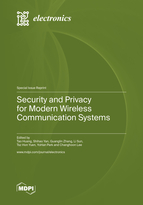Security and Privacy for Modern Wireless Communication Systems
A special issue of Electronics (ISSN 2079-9292). This special issue belongs to the section "Microwave and Wireless Communications".
Deadline for manuscript submissions: closed (31 January 2023) | Viewed by 24039
Special Issue Editors
Interests: deep learning; intelligent sensing; computer vision; pattern recognition; wireless communications; IoT security
Special Issues, Collections and Topics in MDPI journals
Interests: UAV-aided communications; covert communications; covert sensing; location spoofing detection; physical layer security; and IRS-aided wireless communications
Special Issues, Collections and Topics in MDPI journals
Interests: mobile edge computing offloading; reinforcement learning for microgrids; online learning for VANET caching optimization for wireless networks; SDN and applications in UAV and the IoT for industry applications
Special Issues, Collections and Topics in MDPI journals
Interests: physical layer security, wireless AI, B5G/6G wireless communication systems, Internet of Things, R&D of experimental platform for wireless communications
Interests: cryptography; privacy-preserving protocols; blockchain
Special Issues, Collections and Topics in MDPI journals
Interests: network security; security of IoT; blockchain; post-quantum cryptography; security of VANETs; formal analysis
Special Issues, Collections and Topics in MDPI journals
Interests: cyber threat intelligence (CTI); information security; digital forensics; IoT and Cloud security; cryptography
Special Issues, Collections and Topics in MDPI journals
Special Issue Information
Dear Colleagues,
Security and privacy are always critical issues in wireless communication systems. To tackle these issues, novel designs of cryptography, physical layer transmission strategies, network protocol, and related regulations are in high demand. In the last decade, there has been a significant evolvement in wireless communication networks from many aspects.
Firstly, research on wireless communication systems is now starting to move from 5G to 6G. As a result, there will be further increased device connectivity and information flow in wireless networks. In addition, some emerging new applications, e.g., remote real-time medical services and patient care, require confidential data only to be received and processed by the intended service provider.
Secondly, the development of the Internet of Things (IoT) has become a major driver of automation in many applications, such as smart homes, precision agriculture, and intelligent manufacturing. However, design parameters such as packet length, transmission pattern, and time delay vary significantly for different applications, thus introducing unique challenges in the related security and privacy designs. For example, lightweight cryptography is desired for power-constrained IoT systems.
Thirdly, the development and introduction of new technologies, such as intelligent reflection surface, edge/fog/cloud computing, blockchain, deep learning, and cyber twin, into the wireless communication system design bring new opportunities and challenges in guaranteeing information security and user privacy.
This Special Issue focuses on the latest protocol research, software/hardware development and implementation, and system architecture design in addressing the emerging security and privacy issues for modern wireless communication networks. Relevant topics include but are not limited to the following:
- Deep-learning-based security and privacy design;
- Covert communications;
- Information-theoretical foundations for advanced security and privacy techniques;
- Lightweight cryptography for power-constrained networks;
- Physical-layer key generation;
- Prototype and testbed for security and privacy solutions;
- Encryption and decryption algorithm for low-latency constrained networks;
- Security protocols for modern wireless communication networks;
- Network intrusion detection;
- Physical layer design with security consideration;
- Anonymity in data transmission;
- Vulnerabilities in security and privacy in modern wireless communication networks;
- Challenges of security and privacy in node–edge–cloud computation;
- Security and privacy design for low-power wide-area IoT networks;
- Security and privacy design for vehicle networks;
- Security and privacy design for underwater communications networks;
- Blockchain-based solutions for modern wireless communication networks.
Dr. Tao Huang
Dr. Shihao Yan
Prof. Dr. Guanglin Zhang
Prof. Dr. Li Sun
Prof. Dr. Tsz Hon Yuen
Prof. Dr. Yohan Park
Prof. Dr. Changhoon Lee
Guest Editors
Manuscript Submission Information
Manuscripts should be submitted online at www.mdpi.com by registering and logging in to this website. Once you are registered, click here to go to the submission form. Manuscripts can be submitted until the deadline. All submissions that pass pre-check are peer-reviewed. Accepted papers will be published continuously in the journal (as soon as accepted) and will be listed together on the special issue website. Research articles, review articles as well as short communications are invited. For planned papers, a title and short abstract (about 100 words) can be sent to the Editorial Office for announcement on this website.
Submitted manuscripts should not have been published previously, nor be under consideration for publication elsewhere (except conference proceedings papers). All manuscripts are thoroughly refereed through a single-blind peer-review process. A guide for authors and other relevant information for submission of manuscripts is available on the Instructions for Authors page. Electronics is an international peer-reviewed open access semimonthly journal published by MDPI.
Please visit the Instructions for Authors page before submitting a manuscript. The Article Processing Charge (APC) for publication in this open access journal is 2400 CHF (Swiss Francs). Submitted papers should be well formatted and use good English. Authors may use MDPI's English editing service prior to publication or during author revisions.
Keywords
- physical-layer security
- covert communications
- information-theoretical foundations
- lightweight cryptography
- privacy
- key generation
- security protocols
- intrusion detection
- machine learning
- blockchain
- prototype and testbed












